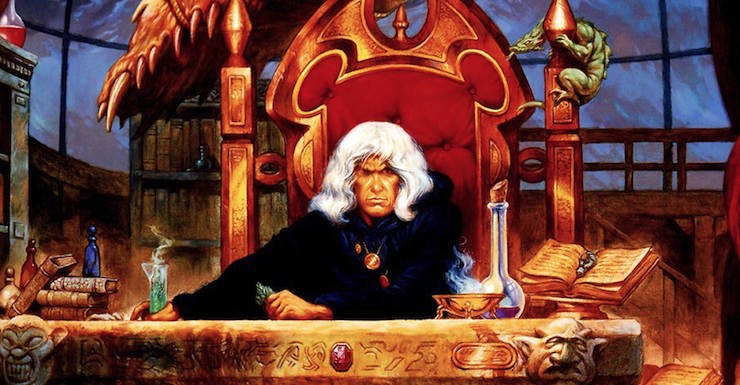Part of the joy of rereading Dragonlance is realising how influential and far-reaching they are. Everyone’s read Dragonlance—and, if not, isn’t now the perfect time to start? It is no wonder this series is so influential; it had its sticky claws in all of our childhoods. To demonstrate this, and to give us the occasional week off, we’ve asked some authors and artists and general figures of the fantastic to chime in with guest posts. They’ll take the reins for a post, and talk through what Dragonlance means to them.
Before we start on the second book in the Dragonlance Chronicles, here is Guest Highlord Jason Heller, on why Raistlin is so great.
Caution: unlike our normal reread posts, this contains spoilers for the rest of the Chronicles. But you probably would’ve gathered that from the title.
A bolt of inspiration hit me like, well, like a bolt. I could barely contain my excitement. Was I a genius? Yes. Yes, after all these years, I finally had confirmation that I was a genius.
My friends and I were in the midst of rolling up zero-level characters for Dungeon Crawl Classics, our latest tabletop RPG obsession, and I’d just hit on the perfect relationship between two of my PCs. Are you sitting down? Check this out: One of them would be sickly, introverted, and complex, while the other would be more simple, more strapping, more outgoing. One would be a warrior, and the other would be a wizard. And even more mind-blowing? They were going to be twins!
It took me all of thirty seconds after that bolt of inspiration hot me to realize it had been more like a bolt of plagiarism. Granted, my brain had shuffled around the details here and there—my warrior was the sickly one, perversely enough—but there was no denying the fact that my twin PCs were thinly veiled versions of Raistlin and Caramon Majere, two of Dragonlance’s most revered and indelible characters.
Not that I was surprised by my accidental theft. Raistlin was in by blood. I started reading the original Dragonlance series, Dragonlance Chronicles Trilogy, when I was twelve. I bought the first book, Dragons of Autumn Twilight, when it came out, and it flambéed my brain. I’d already gotten into Dungeons and Dragons, but here was an epic campaign being translated into prose. And it was good. Scrawny, withdrawn, and maybe a little more bitter and brooding than might have been good me (even at the tender age of twelve!), I related to the twisted wizard Raistlin in a way I’d never related to a fantasy character before—not even Garion, the hero of my other favorite fantasy series of the time, David Eddings’ Belgariad, a kid whose milk-fed wholesomeness was certainly fetching but in no way pertained to my own demeanor or life.
Raistlin, on the other hand, was weird, shifty, convoluted, and cruel, yet given to startling bursts of compassion and empathy. Sure, I also loved Caramon—Raistlin wouldn’t have worked as a character without his fraternal foil—and I adored Tasslehoff Burrfoot, the little kender thief. But Raistlin? He was deep. Paradox and complexity thrived in him. I’m not saying it was entirely healthy to idolize such a creep, as compelling as he was, but Raistlin scratched an itch I didn’t even realize I had: the need for a fantasy character that resonated as deeply as any ancient legend, yet wasn’t so obvious and one-dimensional. I don’t think I’d heard the word “antihero” when I was twelve, but I’d just discovered one.
My friends and I got into Dungeon Crawl Classics because it’s a glorious, unapologetic throwback to the wild and wonky era of old-school gaming, which we’d all gotten into together as kids in the ’80s. The power of that era still holds sway over us, even as RPGs (and fantasy in general) have gotten slicker, grimmer, and more popular. There’s something indelible about the archetypes that Hickman and Weis were dealing with in Dragonlance. They didn’t invent those underlying archetypes. The way they repurposed them and plugged them into their specific mythos, however, opened my eyes to the way this could be done—and had already been done—in everything from Star Wars to The Belgariad and beyond.
And since those underlying archetypes aren’t the exclusive inventions of Hickman and Weis, I feel slightly less bad about, you know, borrowing them. Then again, maybe I’m just thinking like Tasslehoff.
Jason Heller is the author of Taft 2012, a contributor to The Time Traveler’s Almanac, and a Hugo-winning former nonfiction editor of Clarkesworld, a Senior Writer for The A.V. Club and a book reviewer for NPR, and his short fiction appears in Apex Magazine, Farrago’s Wainscot, and the upcoming Swords v. Cthulhu anthology. Find him on Twitter at @jason_m_heller.










